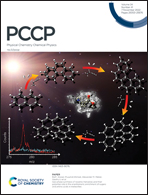In-plane CrI2/CrI3 2D superlattices: novel electronic properties and strain induced phase transition†
Abstract
Two-dimensional (2D) magnetic materials show promising applications in spintronic devices. Heterostructures and superlattices play an important role in property tuning and device design. Vertical heterostructures of 2D magnets have been widely studied while the study of in-plane heterostructures is quite limited. Here, based on density functional theory, we propose that a perfect CrI2/CrI3 in-plane heterostructure or superlattice can be obtained via deposition of Cr atoms on the CrI3 monolayer. Our results show that CrI2/CrI3 superlattices are magnetic semiconductors with the magnetic order depending on the width of the CrI2 ribbon. Interestingly, space charge separation exists in CrI2/CrI3 superlattices independent of the width of CrI2 and CrI3 ribbons. Under appropriate excitation, holes accumulate in the CrI2 part of the superlattice and 100% spin polarized electrons accumulate in the CrI3 part. A 3% tensile strain on the superlattice will induce a phase transition of the CrI2 part. Nevertheless, the space charge separation in the CrI2/CrI3 superlattice occurs under tensile strain smaller than 6%. The tunable magnetic order and robust space charge separation indicate promising applications of CrI2/CrI3 superlattices in spintronic devices.



 Please wait while we load your content...
Please wait while we load your content...